![]()
![]()
![]()
Use LEFT and RIGHT arrow keys to navigate between flashcards;
Use UP and DOWN arrow keys to flip the card;
H to show hint;
A reads text to speech;
154 Cards in this Set
- Front
- Back
|
Difference between introduced species and invasive species
|
Invasive species cause harm
|
|
|
Difference in extinction rate between freshwater and terrestrial fauna in North America
|
Extinction rate of freshwater fauna is five times faster than terrestrial fauna
|
|
|
Term for the ecosystem of a lake
|
Lentic ecosystem
|
|
|
3 geological types of lakes (depression in bedrock)
|
Glacial scour
Volcanic - Crater lakes Tectonic - Rift lakes |
|
|
Characteristics of geologically formed lakes
|
Often large and deep
|
|
|
2 types of lakes formed by depressions in sediment
|
Glacial sediments (e.g. Lake district tams)
Fluvial sediments (e.g. Oxbow lakes) |
|
|
Characteristics of lakes formed by depressions in sediment
|
Short lived and shallow
|
|
|
Formation of barrier lakes
|
Lakes formed by land slides, lava flows, ice barriers and glacial moraine
|
|
|
3 Lake thermal stratifications
|
Epilimnion
Metalimnion (thermocline) Hypolimnion |
|
|
Determinants of thermocline depth
|
Wave size (transfer of heat)
Water clarity (depth of penetration) Duration of calm conditions (heating time) |
|
|
Monomictic lake
|
Single period of stratification and mixing (warm temperate)
|
|
|
Polymictic lake
|
Stratified by day, mixed at night (shallow tropical)
|
|
|
Oligomictic lake
|
Stable statification, rare mixing by storms (Deep tropical)
|
|
|
Seiche
|
Oscillation of water in a lake
|
|
|
Littoral zone
|
Part of a sea, lake or river that is close to the shore
|
|
|
Dimictic lake
|
A lake that mixes from top to bottom during two mixing periods each year
|
|
|
Characteristics of rivers which decrease as you move downstream
|
Gradient: Steep > Level
Turbulence: Turbulent > Smooth Substrate size: Rock > gravel > sand > Silt Less erosion of new material |
|
|
3 River zones
|
Erosion zone
Sediment transport zone Sediment deposition zone |
|
|
Characteristics of a river erosive zone
|
Steep slope
Large substrate Turbulent flow |
|
|
Characteristics of a river sediment transport zone
|
Reduced gradient
Deposition balanced by erosion Gravel and sand substrate Smoother flow |
|
|
Characteristics of a river sediment deposition zone
|
Sediment deposited
Little erosion of new material Silty substrate |
|
|
Characteristics of a river riffle
(riffle-pool sequence) |
Fast flow,
shallow, large substrate, steep gradient |
|
|
Characteristics of a river pool
(riffle-pool sequence) |
Slow flow
Deep finer substrate Lower gradient |
|
|
Characteristic taxa of a riffle
(riffle-pool sequence) |
Ephemeroptera (Mayflies)
Plecoptera (stoneflies) Simulidae (black fly) |
|
|
Characteristic taxa of a pool
(riffle-pool sequence) |
Odonata (dragonflies/damselflies)
Diptera (Flies) Coleoptera (Beetles) |
|
|
River flood refugia
|
Flood plain (out)
Hyporheic zone (down) Within channel (stay and hide) |
|
|
Nitrate Ion
|

|
|
|
Nitrite Ion
|

|
|
|
Ammonia
|

|
|
|
Biological nitrogen fixation formula
|

|
|
|
Organisms capable of nitrogen fixation
|
Free living bacteria
Symbiotic bacteria in legumes/clover Cyanobacteria |
|
|
Enzyme involved in nitrogen fixation
|
Nitrogenase
|
|
|
Important nitrogenase cofactors
|
Molybdenum
Iron |
|
|
Environment where Nitrogen fixation takes place and why
|
Nitrogen fixation occurs in specialised cells or anaerobic microzones
- Nitrogen fixation is inhibited by Oxygen |
|
|
Why N fixation is limited in a marine compared to a freshwater environment
|
Competition between sulphate and molybdate inhibits Mo uptake
|
|
|
Ideal Nitrogen/Phosphorus ratio
|
16:1
|
|
|
Nutrient conditions of a freshwater system where cyanobacteria are favoured over green algae
|
Nitrogen/Phosphorus ratio <16
(Nitrogen limited) |
|
|
Nitrification formula
|

|
|
|
Conditions which inhibit nitrification
|
Low O2
Low pH (nitrification creates H+) |
|
|
Examples of Dissolved Inorganic Nitrogen (DIN)
|
NO3- (Nitrate)
NO2- (Nitrite) NH4+ (Ammonium) |
|
|
Example of Dissolved Organic Nitrogen (DON)
|
Amino Acids
|
|
|
Denitrification formula
|

|
|
|
Inhibitor of denitrification
|
Oxygen
|
|
|
Ammonification formula
|
Organic matter (urine, faeces, dead organisms) --> NH3
|
|
|
Eutrophication
|
Over-fertilization of lakes with nutrients and the changes that occur as a result
|
|
|
Primary producers in lotic (flowing) systems
|
Attached algae and macrophytes (aquatic plants)
|
|
|
Primary producers in lentic (standing) systems
|
Phytoplankton (unless very shallow or very eutrophic)
|
|
|
Inorganic forms of Phosphorus
|

|
|
|
Biological uses for Phosphorus
|
Nucleic acids
ATP/NADP Phospholipids Bones and teeth |
|
|
Sources of Phosphorus
|
Apatite (primary mineral rock)
Phosphorite (sedimentary rock) Organic Matter |
|
|
Carbon dioxide + Water ->
|

Carbonic acid
|
|
|
Weathering caused by carbonic acid
|
Carbonation weathering
|
|
|
How weathered Orthophosphate may be lost
|
Lost in runoff
|
|
|
How weathered Orthophosphate may be occluded
|
Locked in Fe and Al oxides
|
|
|
How weathered Orthophosphate may be nonoccluded
|
Held on soil particles
|
|
|
How weathered Orthophosphate may be used biologically
|
Taken up by plant roots/phytoplankton
Assimilated by soil microbes |
|
|
How microbes and plant roots may increase weathering to liberate phosphates
|
Secretion of organic acids
|
|
|
pH at which phosphorus is most biologically available
|
7
|
|
|
Fate of phosphorus in a low pH environment
|
Bound to Fe and Al oxides
|
|
|
Fate of phosphorus in a high pH environment
|
Bound to Ca minerals
|
|
|
Affect of oxygen on Phosphorus availability
|

|
|
|
Affect of salinity on Phosphorus availability
|

|
|
|
pH of rivers and why
|
Slightly acidic due to high concentrations of CO2 and humic material
|
|
|
pH of the ocean
|
~8
|
|

Circular disk used to measure water transparency in oceans and lakes
|

Secchi disk
|
|
|
inertia and viscosity
|
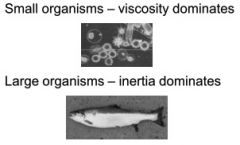
|
|
|
Anatomical adaptations to resist flow
|
Production of silk or sticky secretions
Suckers or hooks Body streamlined or flattened |
|
|
Influence of depth on velocity of flowing water
|

|
|
|
3 classifications of drift
|
Constant
Catastrophic Behavioural |
|
|
Time of day when behavioural drift by macro-invertebrates increases in freshwater
|
Higher at night - less visual predation
|
|
|
Aquatic marginal wetlands
|

Wetland fed from a parent water body
(Fringe or flood) |
|
|
Fringe wetland
|

Aquatic marginal wetland with a continuous or very frequent connection with a parent water body
|
|
|
Flood wetland
|

Aquatic marginal wetland only connected with a parent water body during high water
|
|
|
Mire wetland
|

Wetland which persists independently of a parent water body
(Fen or Bog) |
|
|
Fen wetland
|
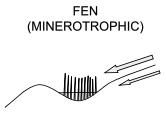
Valley mire wetland which receive water from groundwater and runoff
Generally nutrient rich |
|
|
Bog wetland
|
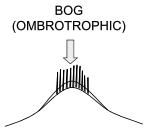
Mire wetland fed solely by rainwater and aerial deposition
Generally nutrient poor |
|
|
Diffusion of Oxygen in water compared to air
|
Oxygen diffuses 10,000 times slower in water compared to air
|
|
|
Why waterlogged soil tends to be deficient in nitrate
|
Anaerobic conditions promotes bacterial denitrification
NO3- --> N2 |
|
|
Why wetlands tend to contain increased toxic chemical species
|
Absence of oxygen creates reduced forms of metal ions which are more chemically reactive
|
|
|
Examples of reduced toxic chemical species found in wetlands
|

|
|
|
Aerenchyma
|

Air channel in the roots of some plants, which allows exchange of gases between the shoot and the root
|
|
|
Paraphyletic group and a genus of bacteria which fix nitrogen
|
paraphyletic group: Rhizobia
Genus: Frankia |
|
|
plants characterized by their ability to form a symbiosis with the nitrogen fixing actinobacteria Frankia
|
Actinorhizal plant
|
|
|
Example of an actinorhizal plant
|
Alder (Alnus glutinosa)
|
|
|
Delay in development in response to regularly and recurring periods of adverse environmental conditions
|
Diapause
|
|
|
Non-living particulate organic material; typically including the bodies or fragments of dead organisms and fecal material
|
Detritus
|
|
|
A genus of between 151 and 350 species of mosses commonly called peat moss
|
Sphagnum moss
|
|
|
Why biomonitoring is preferable to chemical monitoring
|
Organisms respond to intermittent pollution,
Organisms are sensitive to low levels of pollution, Organisms may be sensitive to new or unexpected pollutants Organisms reflect the impacts of multiple pollutants. |
|
|
Disadvantages to detecting pollution by monitoring a single species
|
Abundance of species may be affected by variables other than pollution
e.g. Seasonal variation habitat availability weather temperature |
|
|
Bioaccumulation
|
Low levels of pollutants magnified within organism
Useful for biomonitoring |
|
|
Examples of species which exhibit bioaccumulation useful for biomonitoring
|
High trophic level species
Bryophytes, Molluscs, Fish |
|
|
Why communities are generally used for biomonitoring
|
Wide range of tolerances
Sensitive to different pollutants Loss of particularly sensitive species registers subtle effects |
|
|
Species extremely sensitive to sewerage pollution but immune to acidification
|
Stoneflys
|
|
|
Characteristics of a species suitable for biomonitoring
|
Presence/absence related to water quality, not other factors
Integration of conditions over time, not just current situation Not too mobile - Reflection of sampling site, not elsewhere Easy to identify |
|
|
Advantages of using bacteria for biomonitoring
|
Huge populations
Widely distributed |
|
|
Disadvantage of using bacteria for biomonitoring
|
Not easily identified
|
|
|
Advantage of using algae for biomonitoring
|
Sensitive to nutrient enrichment
|
|
|
Disadvantages of using algae for biomonitoring
|
Seasonal changes in abundance
Lots of samples required |
|
|
Advantages of using macrophytes for biomonitoring
|
Easy to identify
Good indicator of nutrient levels |
|
|
Disadvantages of using macrophytes for biomonitoring
|
Seasonal changes in abundance
Obtain nutrients from both water and sediment |
|
|
Advantages of using fish for biomonitoring
|
Easy to identify
Reflect changes lower in food chain |
|
|
Disadvantages of using fish for biomonitoring
|
Highly mobile
Difficult and expensive to sample |
|
|
Advantages of using macro-invertebrates for biomonitoring
|
Widely distributed
Broad spectrum of tolerances Relatively sedentary Relatively long lifespan - present most of year Easy to sample and ID |
|
|
Disadvantages of using macro-invertebrates for biomonitoring
|
Seasonal variation in community
Vary with other factors (habitat) Aggregated – lots of samples needed |
|

Scale used to categorise the particle size of a substrate
|
Wentworth scale
- Negative log2 of smallest diameter (mm) |
|
|
Examples of living organic substrates in freshwaters
|
Biofilms
Algal mats Macrophytes |
|
|
Examples of dead organic substrates in freshwaters
|
– Coarse woody debris (CWD) >8cm
– CPOM (>1mm) (leaves etc.) – FPOM (<1mm, > 0.5μm) – DOM (> 0.5 μm) |
|
|
Examples of freshwater rock taxa (lithophilous)
|

Water penny (Psephenidae) – underside of rocks
Freshwater sponges (Spongillidae) – large stable rocks |
|
|
Adaptations of freshwater sand taxa (Psammophilous)
|

Lestinogomphus africanus Dragonfly - Syphon, hairy (prevents sand particles penetrating joints)
Meiofauna (<0.5mm) |
|
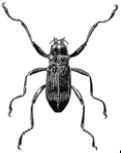
Example of a freshwater species which processes large woody debris (Xylophilous)
|
Riffle beetles (Elmidae) - Large claws to hold on
-Rare due to removal of wood from rivers |
|

Characteristic fauna living on plants (Phytophilous)
|
Moss: caseless caddis
Macrophytes: More complex plant = higher diversity and abundance |
|
|
Effect of temperature on maximum oxygen concentration in freshwater
|
Cold water can hold more oxygen
Halves between 0 - 30C Rivers near saturation (turbulence) |
|
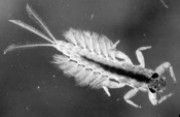
Freshwater organisms with gills
|
fish, Ephemeroptera, Trichoptera
Diffuses across concentration gradient Dependent on flow to replenish water |
|
|
Freshwater organisms with lungs
|

lungfish, amphibians, pulmonate snails
Dependent on access to surface |
|
|
Freshwater organisms which use air bubbles
|
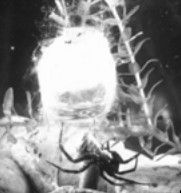
water beetles, water spiders
|
|
|
Physical gills
|
structure common among some types of aquatic insects, which holds atmospheric oxygen in an area with small openings called spiracles. The structure (often called a plastron) typically consists of dense patches of hydrophobic setae on the body, which prevent water entry into the spiracles.
|
|
|
Adapted to a narrow temperature range
|
Stenothermic
|
|
|
Adapted to a wide temperature range
|
Eurythermic
|
|
|
Term used to indicate the number of generations per year
|
voltinism
Univoltine - 1 gen/year Bivoltine - 2 gen/year Multivoltine > 2 gen/year Semivoltine < 1 gen/year |
|
|
Examples of behavioural adaptations to increase flow of water over respiratory structures
|
Plecoptera (stoneflies) – do ‘press-ups’ to increase water flow
Ephemerella (mayfly) – beats its gill plates |
|
|
How temperature generally affects voltinism
|

|
|
|
Autochthonous energy in freshwater systems
|
Energy sourced from primary production by photosynthesis by Phytoplankton, biofilm and macrophytes
|
|
|
Allochthonous energy in freshwater systems
|
Energy imported from elsewhere: Detritus
|
|
|
CPOM
|
Coarse Particulate Organic Matter
>1mm |
|
|
FPOM
|
Fine Particulate Organic Matter
0.5μm - 1mm |
|
|
DOM
|
Dissolved Organic Matter
<0.5μm |
|
|
Periphyton
|

A complex mixture of algae, cyanobacteria, heterotrophic microbes, and detritus that is attached to submerged surfaces in most aquatic ecosystems
|
|
|
River continuum concept
|
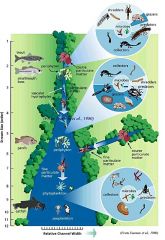
Conceptual model which predicts changes in river energy sources and function with increasing stream order
|
|
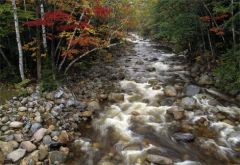
River Continuum Concept predictions concerning low-order streams
|

Shaded - High detrital inputs
Shredders predominate Low Productivity/Respiration ratio Low FPOM/CPOM ratio |
|
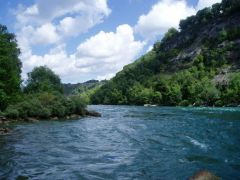
River Continuum Concept predictions concerning high-order streams
|

No shading - detritus unimportant
Macrophytes abundant Collector-filterers dominate Low Productivity/Respiration ratio High FPOM/CPOM ratio |
|
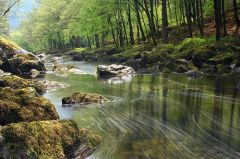
River Continuum Concept predictions concerning mid-order streams
|

Less shading - lower detritus
Abundant periphyton and FPOM Grazers dominate Highest Productivity/Respiration ratio |
|
|
Ontogenetic diet shift
|
Changing of feeding strategy throughout development
|
|
|
Example of a species with an ontogenetic diet shift
|
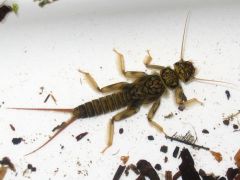
Stonefly - shift from eating plant material to carnivory
|
|
|
Five functional feeding groups exhibited by freshwater macro-invertebrates
|
Scrapers/Grazers
Shredders Predators Collector-gatherers Collector-filterers |
|
|
Examples of freshwater scrapers/gathers
|
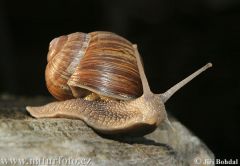
Snails (Gastropoda)
Fish (Pisces) Mayflies (Ephemeroptera) |
|
|
Examples of freshwater shredders
|

Amphipods
Isopods Caddisflies (Trichoptera) Stoneflies (Plecoptera) |
|
|
Examples of engulfing freshwater predators
|
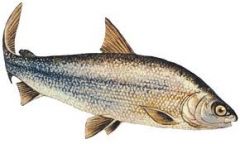
Dragonflies (Odonata)
Stoneflies (Plecoptera) Fish (Pisces) |
|
|
Examples of freshwater collector-gatherers
|
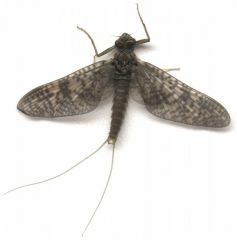
Mayflies (Ephemeroptera)
Caddisflies (Trichoptera) True flies (Diptera) |
|
|
Examples of freshwater collector-filterers
|
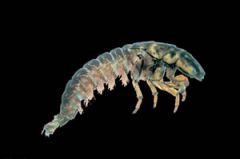
Caddisflies (Trichoptera)
True flies (Diptera) Zooplankton (Copepoda) |
|
|
Gape limited predator
|
Size of prey limited by size of predator's mouth
|
|
|
Example of a piercing freshwater predatory taxa
|

True bugs (Hemiptera)
|
|
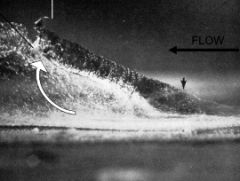
Methods of passive filter feeding
|
simple sieves
• Net-spinning caddis larvae • Size of particles restricted by size of sieve • Small organisms – difficult to sieve water due to high viscosity sticky screens • Individual fibres of appendage sticky • Can capture particles smaller than aperture of sieve • Simulium (Diptera) – blackfly larva with fans on head |
|
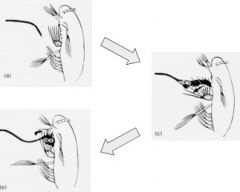
Method of active filter feeding
|
Scan and trap
• Zooplankton – copepods • Generate current using appendages • Active detection of particles – chemicals in surrounding water • Open and close feeding appendages as particle passes |
|
|
Alternative stable states of shallow lakes
|
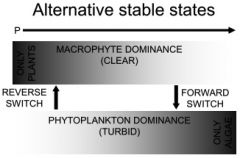
|
|
|
Evidence for 'alternative stable states' in shallow lakes
|

|
|
|
Buffer mechanism which resists the change of a shallow lake from plant dominated to algal dominated
|
Plants provide refuges for grazing zooplankton from fish predation
|
|
|
Buffer mechanism which resists the change of a shallow lake from algal dominated to plant dominated
|
Phytoplankton outcompete plants for nutrients preventing establishment
|
|
|
Events which trigger shallow lakes to switch from plant dominated to algal dominated
|
Destruction of plants:
- For boating - Herbicide application or runoff Alteration of food web structure: – Loss of zooplankton (insecticides) – Decrease in piscivorous fish (fishing) |
|
|
Likely state of a shallow lake with a high phosphorus concentration
|
Phytoplankton / Algal dominated
|
|
|
Likely state of a shallow lake with a low phosphorus concentration
|
Plant / Macrophyte dominated
|
|
|
Bottom-up solutions to remediate a eutrophicated lake
|
Reduce nutrient inputs (cut off source)
Take out sediment (contains lots of P) |
|
|
Top-down solution to remediate a eutrophicated lake
|
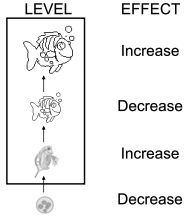
Biomanipulation – manipulation of the food web to increase grazing of algae via a trophic cascade
– Removal of all fish – Removal of zooplanktivores – Increased stocking of piscivores |
|
|
Phytoplankton seasonality in lake ecosystems / Temperate lake succession
|
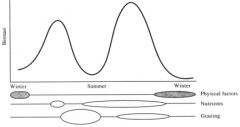
SPRING peak of Diatoms - Mixing
SUMMER decline: Stratification - nutrient limitation, grazing by crustaceans / zooplankton AUTUMN peak - breakdown of thermocline, change in species: cyanobacteria WINTER: Mixing, low production despite nutrients |
|
|
Experimental addition of phosphorus to a lake
|
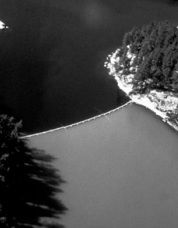
Huge growth of phytoplankton
|

